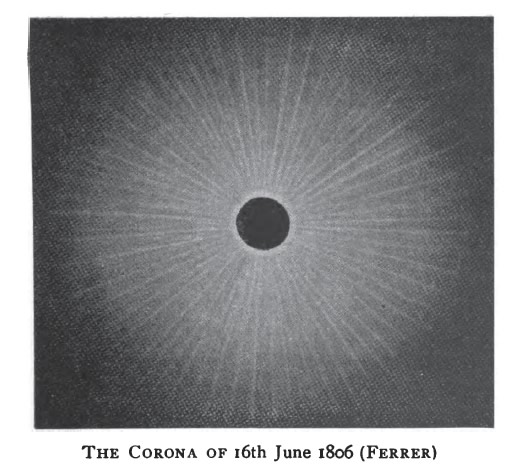Chronicling the eclipse in Albany... in 1806

Because eclipse: On June 16, 1806 there was a total eclipse, and the path of totality passed pretty much directly over the Albany area. It was, in the words of Simeon De Witt, a "sublime spectacle" that fixed "the gaze of man in silent amazement" for several minutes.
De Witt was the Surveyor General of New York State at the time and worked from the Capitol in Albany. He summarized the experience of the eclipse in a letter to Benjamin Rush and the American Philosophical Society. Accompanying the letter: a painting the eclipse by the noted local portraitist Ezra Ames (more on that in a second). A clip:
[The painting] gives, I believe, as true a representation of that grand and beautiful phenomenon, as can be artificially expressed. The edge of the moon was strongly illuminated, and had the brilliancy of polished silver. No common colours could express this; I therefore directed it to be attempted as you will see, by a raised silvered rim, which in a proper light, produces tolerably well, the intended effect.
As no verbal description can give any thing like a true idea of this sublime spectacle, with which mani is so rarely gratified, I thought this painting would not be an unwelcome present to the Society, or an improper article to be preserved among its collection of subjects for philosophlical speculation. But, in order to have a proper conception of what is intended to be represented, you must transfer your ideas to the heavens, and imagine, at the departure of the last ray of the sun, in its retreat belhind the moon, anl awfful gloom immediately diffused over the face of nature; and round a dark circle, near the zenitlh, an immenise radiated glory, like a new creation, in a moment bursting on the sight, and for several miniutes fixing the gaze of man in silent amazement.
The luminotus circle on the edge of the moon, as well as the rays which were darted from her, were remarkably pale, and had that bluish tint, which distinguishes the colour of quicksilver from a dead white.
De Witt's account includes detailed estimations -- expressed in latitude and longitude -- of the width of the shadow, which, based on reports, he figured had stretched from Granville in Washington County on the north side to the town of Montgomery in Orange County on the south side, with the center passing through New Baltimore. (Based on the coordinates he included for himself, De Witt observed the eclipse at a spot roughly where the Albany Academy for Girls now stands.)
The Ames painting
And what of the Ames painting of this glorious sight? It was lost -- somewhere.
But an engraving based on the painting was preserved in Random Recollections of Albany: From 1800 to 1808 by Gorham A. Worth, a banker who had lived here. (The collection was later published by Joel Munsell.) That's a clip above that included the engraving.
In De Witt's letter to Benjamin Rush, he notes that the painting created by Ezra Ames was very similar to one made by José JoaquÃn de Ferrer in Kinderhook:

via Eclipses of the Sun by Mabel Loomis Tood (1900) / Wikipedia
Ferrer was a Spanish astroner and one of the first eclipse chasers. And it was based on his viewing of the 1806 eclipse in Kinderhook that he was the first person to use the term corona to described the wisps of plasma that emanate from the sun like a crown.
[via @SchreckTroyson and @AlbanyMuskrat]
2024
Another total eclipse will be visible in the United States in 2024, and the path of totality will slice across the northern portion of New York State.
... said KGB about Drawing: What's something that brought you joy this year?